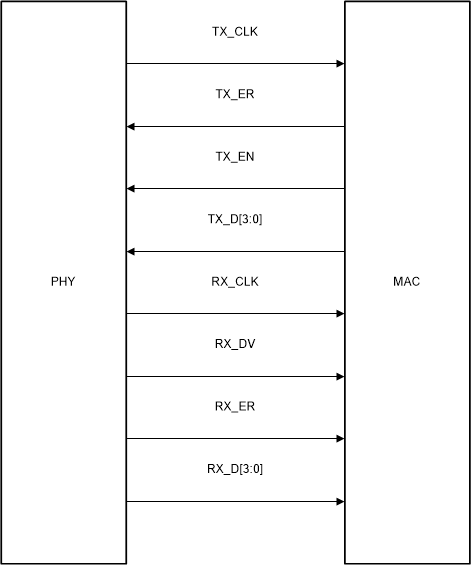ZHCSQL1 May 2022 DP83TC813R-Q1 , DP83TC813S-Q1
PRODUCTION DATA
- 1 特性
- 2 应用
- 3 说明
- 4 Revision History
- 5 Device Comparison Table
- 6 Pin Configuration and Functions
- 7 Specifications
-
8 Detailed Description
- 8.1 Overview
- 8.2 Functional Block Diagram
- 8.3 Feature Description
- 8.4
Device Functional Modes
- 8.4.1 Power Down
- 8.4.2 Reset
- 8.4.3 Standby
- 8.4.4 Normal
- 8.4.5 Sleep Ack
- 8.4.6 Sleep Request
- 8.4.7 Sleep Fail
- 8.4.8 Sleep
- 8.4.9 Wake-Up
- 8.4.10 TC10 System Example
- 8.4.11 Media Dependent Interface
- 8.4.12 MAC Interfaces
- 8.4.13 Serial Management Interface
- 8.4.14 Direct Register Access
- 8.4.15 Extended Register Space Access
- 8.4.16 Write Address Operation
- 8.4.17 Read Address Operation
- 8.4.18 Write Operation (No Post Increment)
- 8.4.19 Read Operation (No Post Increment)
- 8.4.20 Write Operation (Post Increment)
- 8.4.21 Read Operation (Post Increment)
- 8.5 Programming
- 8.6 Register Maps
- 9 Application and Implementation
- 10Power Supply Recommendations
- 11Layout
- 12Device and Documentation Support
- 13Mechanical, Packaging, and Orderable Information
8.4.12.1 Media Independent Interface
The Media Independent Interface (MII) is a synchronous 4-bit wide nibble data interface that connects the PHY to the MAC. The MII is fully compliant with IEEE 802.3-2015 clause 22. The PHY has internal series termination resistors on MII output pins including TX_CLK output when the PHY is operating in MII mode. In this mode, it is recommended to not leave the MII-TX pins floating or High-Z.
The MII signals are summarized in Table 8-4:
Table 8-4 MII Signals
| FUNCTION | PINS |
|---|---|
| Data Signals | TX_D[3:0] |
| RX_D[3:0] | |
| Control Signals | TX_EN, TX_ER |
| RX_DV, RX_ER | |
| Clock Signals | TX_CLK |
| RX_CLK |
 Figure 8-14 MII Signaling
Figure 8-14 MII SignalingTable 8-5 MII Transmit Encoding
| TX_EN | TX_ER | TX_D[3:0] | DESCRIPTION |
|---|---|---|---|
| 0 | 0 | 0000 through 1111 | Normal Inter-Frame |
| 0 | 1 | 0000 through 1111 | Reserved |
| 1 | 0 | 0000 through 1111 | Normal Data Transmission |
| 1 | 1 | 0000 through 1111 | Transmit Error Propagation |
Table 8-6 MII Receive Encoding
| RX_DV | RX_ER | RX_D[3:0] | DESCRIPTION |
|---|---|---|---|
| 0 | 0 | 0000 through 1111 | Normal Inter-Frame |
| 0 | 1 | 0000 | Normal Inter-Frame |
| 0 | 1 | 0001 through 1101 | Reserved |
| 0 | 1 | 1110 | False Carrier Indication |
| 0 | 1 | 1111 | Reserved |
| 1 | 0 | 0000 through 1111 | Normal Data Reception |
| 1 | 1 | 0000 through 1111 | Data Reception with Errors |